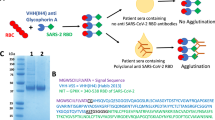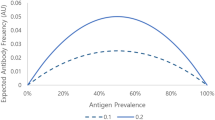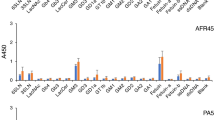Abstract
A QUESTION of current interest is whether the initial stages of an immune response—either the induction of antibody formation or of specific tolerance—may involve the reaction of an antigen with a specific lymphocyte. Naor and Sulitzeanu1 have demonstrated, both in vivo and in vitro, a reaction of 125I-labelled bovine serum albumin with a small proportion (about 1/5,000) of mouse spleen lymphocytes. We have since shown2 that both flagellin and polymerized flagellin (Salmonella adelaide) and haemocyanin (Jasus lalandii) labelled with 125I or 131I react in vitro with certain cells from spleens of rats and mice. Of the strongly reactive cells, almost all are mononuclear with a high nuclear/cytoplasmic ratio and 7–12 microns in diameter and, for any one antigen, comprise about 1/5,000 of the total cell population. These reactive cells adsorb between 4,000–40,000 molecules of labelled protein when allowed to react at 0° C with labelled protein (about 3 × 1012 molecules/ml.) in 10 per cent foetal calf serum. A similar proportion of such reactive cells was observed in cell suspensions from lymph nodes and thoracic duct lymph, while peritoneal exudate contained a higher proportion and thymus a lower proportion of these cells2. The reaction was not inhibited by concentrations of sodium azide which restricted the uptake of labelled antigen by macrophages but was inhibited, using mouse cells, by rabbit anti-mouse globulin serum. Spleen cells from germ-free and conventional mice reacted equally well with 131I-labelled flagellin2. We wished to know whether the ability of these cells to react with antigen was immunologically significant. Experiments were devised to distinguish between the following possibilities: that the reactive cells were (1) cells present because of a prior experience of the animal with a related antigen, (2) antigen-reactive cells3,4 which had not had prior antigenic experience but which were capable of contributing to a specific immune response such as formation and secretion of antibody, and (3) cells coated non-specifically with cytophilic antibody.
This is a preview of subscription content, access via your institution
Access options
Subscribe to this journal
Receive 51 print issues and online access
$199.00 per year
only $3.90 per issue
Buy this article
- Purchase on Springer Link
- Instant access to full article PDF
Prices may be subject to local taxes which are calculated during checkout
Similar content being viewed by others
References
Naor, D., and Sulitzeanu, D., Nature, 214, 687 (1967).
Byrt, P., and Ada, G. L., Immunology (in the press).
Playfair, J. H. L., Papermaster, B. W., and Cole, L. J., Science, 149, 989 (1965).
Kennedy, J. C., Till, J. E., Siminovitch, L., and McCulloch, E. A., J. Immunol., 96, 973 (1966).
Dulbecco, R., and Vogt, M., J. Exp. Med., 99, 167 (1954).
Nossal, G. J. V., Immunology, 2, 137 (1959).
Ada, G. L., Humphrey, J. H., Askonas, B. A., McDevitt, H. O., and Nossal, G. J. V., Exp. Cell Res., 41, 557 (1966).
Moroney, M. J., Facts from Figures, 355 (Penguin Books, London, 1965).
Burnet, F. M., The Impact on Ideas of Immunology, Cold Spring Harbor Symposia, 32, 1 (1967).
Author information
Authors and Affiliations
Rights and permissions
About this article
Cite this article
ADA, G., BYRT, P. Specific Inactivation of Antigen-reactive Cells with 125I-Labelled Antigen. Nature 222, 1291–1292 (1969). https://doi.org/10.1038/2221291a0
Received:
Issue Date:
DOI: https://doi.org/10.1038/2221291a0
This article is cited by
-
One cell–one antibody: prelude and aftermath
Nature Immunology (2007)
-
On RNA interference as template immunity
Journal of Biosciences (2005)
-
The thymus then and now
Immunology & Cell Biology (1994)
Comments
By submitting a comment you agree to abide by our Terms and Community Guidelines. If you find something abusive or that does not comply with our terms or guidelines please flag it as inappropriate.



